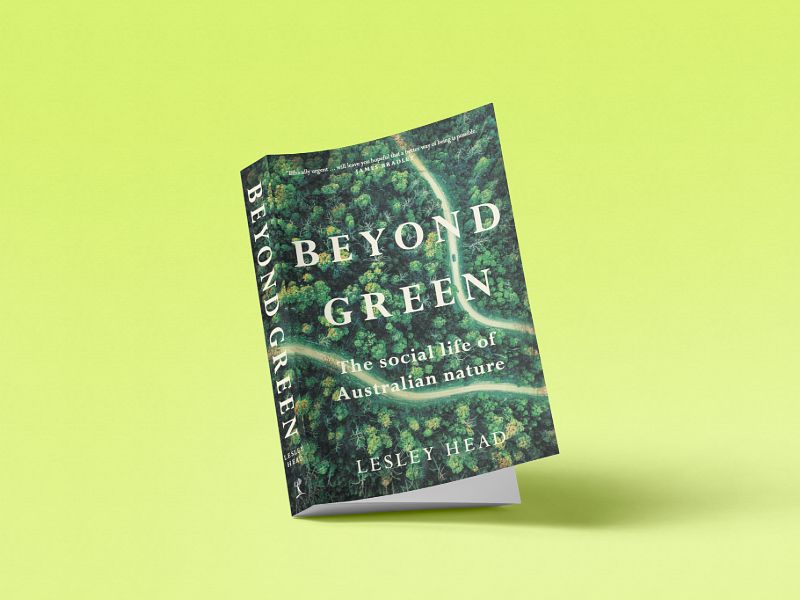Extract: Beyond Green by Lesley Head
Too Much and Not Enough

Culture, society and human behaviour have forever been linked to nature. In her thought-provoking book, Lesley Head, geographer and Redmond Barry Distinguished Professor Emeritus at the University of Melbourne, examines how nature has played a role in shaping Australian life and how this has changed across time and place. Head pays close attention to how these connections are shaped by the challenges of climate change and biodiversity crises as well as the lessons we can learn from Indigenous, settler-descendant and immigrant cultures.
In the below extract from Beyond Green, Head takes a close look at our ongoing relationship with water, both in times of drought and when water appears available in abundance. Head examines how the complex and many different environments, including water infrastructure as well as natural systems and differing rainfall regimes, can lead us to participate in paradoxical behaviours.
The notion of ‘coming to terms’ with the environment is often used to denote the cultural shift that is required for all settler Australians to develop sustainable lifestyles, including those who have been here for generations. The potential usefulness of the concept is undermined if those terms are taken to provide a readymade template for what an appropriate and sustainable human presence in Australia might look like. To start with, there are not one but many Australian environments and rainfall regimes. More to the point, the ‘environment’ is not a standalone phenomenon separate from human existence, but a configuration of connections in which humans and non-humans (plants, animals and the infrastructure of water storage and delivery, among other things) are already embedded.
These complex environments can lead to paradoxical behaviours. Residents on the eastern seaboard were so good at responding to water restrictions and reducing their consumption during the Millennium Drought that people often asked why we couldn’t continue these habits all the time, even when the drought was over. And a number of rural areas have instituted permanent restrictions. But in areas where there is temporary abundance, should we not savour it? I am very good at not running the tap while brushing my teeth, but I’m sure I’m not the only person who enjoys an extra few minutes in the shower when it is raining. My perception here is both disconnected from the infrastructure of supply (it takes a lot of electricity to pump that water and heat it on the way to my shower) and able to enjoy the abundance.
We found a number of manifestations of such connections and disconnections in the backyard study.[i] As with the water tanks, they can push in the direction of both increased and decreased consumption. Part of the reason why householders worked hard to save water in informal practices such as the bucket in the shower, was that they could see and interact with the infrastructure of their water supply. In the relationship between house and garden they could see, understand and participate in the network of water storage and distribution. In contrast to electricity (although this may be changing for those with solar panels on their roof), they were not blissfully ignorant of the networks that produced their domestic comfort. They were catching water off the roof, struggling with the connectors on their drip systems, and digging in drainage systems. They could see that the water cycle had been disrupted when it had not rained for months and street trees were dying. This was not perfect or full knowledge, but it was detailed and ecologically specific, and they engaged with it on a day-to-day basis. To the extent that the garden, or favourite plants, are particularly valued, they were willing to make sacrifices, and inject their own labour into the water network. (In fact, per-capita water consumption in detached houses with gardens in Sydney was little different to that of apartment and unit dwellers during this time.)
The dry continent was often invoked as a motivation for saving water. This could occur even when the actual infrastructure of the person’s region had no connection to arid areas, such as the inner Sydney resident who was inspired to install water tanks after travelling across the Tanami Desert. When a mother in Sydney’s western suburbs told her teenage daughter in the shower to ‘save some water for the farmers, Jess’, she was expressing a broad consciousness of the arid continent rather than a belief that if Jess showered for less than twenty minutes, the farmers would actually get more water.
For people who actually live in the desert, the circumstances can be quite different. Alice Springs residents have less than a quarter of the rainfall and more than double the average household water consumption of those in Sydney. Alice Springs gets its supply from an aquifer which, although dependent on long-term groundwater recharge, has only an indirect connection to rainfall in most people’s understanding. Residents of Alice rely heavily on their domestic environments, both house and garden, for respite from the arid conditions, particularly in summer. The provision of shade was a much stronger driver in shaping these backyards than the east coast ones. Water was important in creating a cool haven, whether through watering plants or having a water feature. In a milder climate, like Sydney’s, surrounded by greenery, people needed less water to enhance their surrounds.
The dry continent theme was often contrasted with the European homelands of Australia’s immigrant population, and the environmental sensibilities developed in a wetter environment. As one Sydney man said, ‘It makes me so cross to think that even two hundred years down the track people are still thinking in terms of the European landscape where you get so much rain. And you can have green lawns.’ In another example, an Australian man and his Belgian-born wife discussed how she planted flowers and watched them die because she didn’t water them. They both attributed this behaviour to not needing to water gardens in Belgium: ‘you see, it rains so much, they don’t have droughts’. In fact, in Belgium the average annual rainfall is about two-thirds that of Wollongong, where they were living.
The point is not that Sydney and Wollongong have abundant water to be poured on gardens; they do not—and there are other influences on the availability of water for gardening, including much higher evaporation rates in Australia than northern Europe, and the different seasonalities of both rainfall and gardening between different places. Rather, it is to emphasise that perceptions and understandings roll together myths in complicated ways.
Backyard water-saving practices were not invulnerable. They coexisted with strong watery desires, expressed as wants, needs and dreams around water. Backyarders expressed a range of sensual and physical engagements with water. It is a part of nature that is usually a source of pleasure. Some desires were for water tanks and other water-saving devices linked to action in the near future, but many more were desires for a water feature, or dreams of having a swimming pool.
- Share
- Posted On 11 Jun 2025
